Takeshi Ikeuchi’s kei truck is a minimalist Japanese mobile showroom
Takeshi Ikeuchi's kei truck design is a Japanese timber specialist’s minimalist mobile showroom
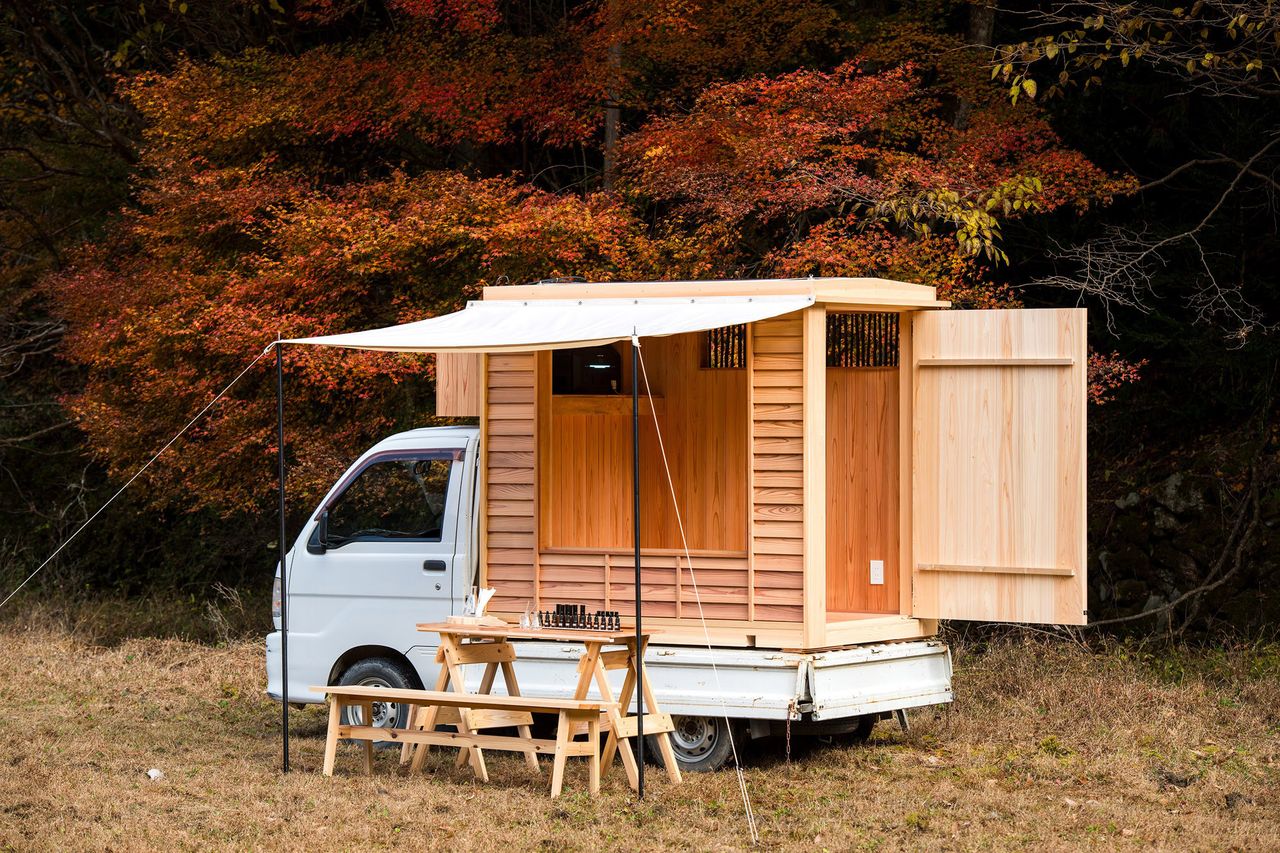
A chance encounter at a forest campsite led to architect Takeshi Ikeuchi’s unusual commission for a moving wooden showroom for timber specialist Takeda Forestry. The initial brief from the company, based in Ehime on Shikoku island, Japan, was to both show off some of its milled sugi (cedar) and hinoki (cypress) planks; and design a showroom on wheels that could be used flexibly – for example as a small shop or for workshops.
‘Takeda’s factory sits in a rural place called Oda, famous for the quality of both types of timber,’ Ikeuchi explains. ‘This is Kei truck country, and we thought, what would be better than using a tiny truck as the base for their moving showroom?’
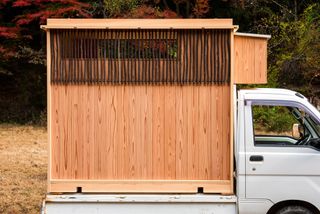
A reimagined kei truck by Takeshi Ikeuchi
Kei trucks are a stalwart of transportation in rural Japan. With a body a little over 3m long and under 1.5m wide, they are perfect for manoeuvering round narrow country roads. While nimble and easy to drive, their relatively large bed can pack up to 350kg, making them the perfect tool to haul farm produce, firewood or timber.
It was indeed the bed of the truck that determined the dimensions of the ‘showroom’ (1.1m wide X 1.7m long), and as traffic regulations only allow for a total vehicle height of 2.5m, the inside of the cabin is a mere 1.5m high. Its two sides have been finished in red knot-free cedar – one side in clapboard, and the other in vertical tongue and groove planks. The ceiling and door at the back are knot-free hinoki wood.
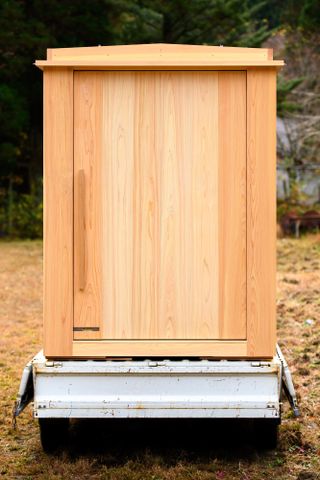
There is a large opening to one side allowing a clear view of the interior. This comes in handy when the showroom is turned into a mobile store. A narrow window on the opposite end is wrapped in a spaced-out row of raw kuromoji branches that bring a rougher, organic touch to the otherwise minimalist exterior.
The roof is covered in a simple tent fabric and features a large solar panel that charges a battery stored in a keyaki wood box on top of the truck’s cab. Hooks have been installed on both sides so a simple tarp can be added to extend the footprint of the showroom as needed.
As with all good Japanese craftsmanship, the finish shows a deep understanding and appreciation of the timber. The wood is left untreated and will undoubtedly age beautifully over time. The wooden structure can easily be removed from the bed of the truck by inserting two standard scaffolding pipes into two holes at the base, and simply lifting the tiny cabin off.
Wallpaper* Newsletter
Receive our daily digest of inspiration, escapism and design stories from around the world direct to your inbox.
‘It was important that the showroom could be lifted on and off easily for flexibility,’ Ikeuchi explains. ‘If the showroom proves a success, Takeda is even considering offering DIY house kits for sale in the future.’ We hope they ship internationally.
A version of this article appears in the April 2024 issue of Wallpaper*, available in print, on the Wallpaper* app on Apple iOS, and to subscribers of Apple News +. Subscribe to Wallpaper* today
Originally from Denmark, Jens H. Jensen has been calling Japan his home for almost two decades. Since 2014 he has worked with Wallpaper* as the Japan Editor. His main interests are architecture, crafts and design. Besides writing and editing, he consults numerous business in Japan and beyond and designs and build retail, residential and moving (read: vans) interiors.
-
 Piaget’s new Sixtie watches recall a glamorous history at Watches and Wonders 2025
Piaget’s new Sixtie watches recall a glamorous history at Watches and Wonders 2025Piaget draws on historical codes with the trapeze-shaped Sixtie watch collection, revealed at Watches and Wonders 2025
By Hannah Silver Published
-
 A contemporary Swiss chalet combines tradition and modernity, all with a breathtaking view
A contemporary Swiss chalet combines tradition and modernity, all with a breathtaking viewA modern take on the classic chalet in Switzerland, designed by Montalba Architects, mixes local craft with classic midcentury pieces in a refined design inside and out
By Jonathan Bell Published
-
 Cartier dials up the glamour at Watches and Wonders 2025
Cartier dials up the glamour at Watches and Wonders 2025Cartier revamps much-loved watch collections, from Privé and Panthère to Tank and Tressage, upping the sparkle at the watch fair in Geneva
By Thor Svaboe Published
-
 Tour the brutalist Ginza Sony Park, Tokyo's newest urban hub
Tour the brutalist Ginza Sony Park, Tokyo's newest urban hubGinza Sony Park opens in all its brutalist glory, the tech giant’s new building that is designed to embrace the public, offering exhibitions and freely accessible space
By Jens H Jensen Published
-
 A first look at Expo 2025 Osaka's experimental architecture
A first look at Expo 2025 Osaka's experimental architectureExpo 2025 Osaka prepares to throw open its doors in April; we preview the world festival, its developments and highlights
By Danielle Demetriou Published
-
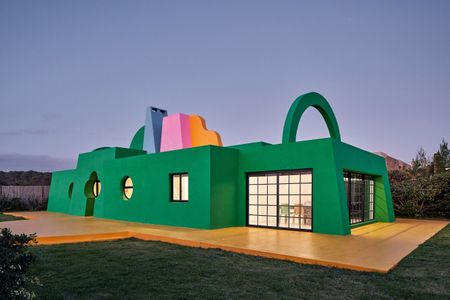 Ten contemporary homes that are pushing the boundaries of architecture
Ten contemporary homes that are pushing the boundaries of architectureA new book detailing 59 visually intriguing and technologically impressive contemporary houses shines a light on how architecture is evolving
By Anna Solomon Published
-
 And the RIBA Royal Gold Medal 2025 goes to... SANAA!
And the RIBA Royal Gold Medal 2025 goes to... SANAA!The RIBA Royal Gold Medal 2025 winner is announced – Japanese studio SANAA scoops the prestigious architecture industry accolade
By Ellie Stathaki Published
-
 Architect Sou Fujimoto explains how the ‘idea of the forest’ is central to everything
Architect Sou Fujimoto explains how the ‘idea of the forest’ is central to everythingSou Fujimoto has been masterminding the upcoming Expo 2025 Osaka for the past five years, as the site’s design producer. To mark the 2025 Wallpaper* Design Awards, the Japanese architect talks to us about 2024, the year ahead, and materiality, nature, diversity and technological advances
By Sou Fujimoto Published
-
 Tadao Ando: the self-taught contemporary architecture master who 'converts feelings into physical form’
Tadao Ando: the self-taught contemporary architecture master who 'converts feelings into physical form’Tadao Ando is a self-taught architect who rose to become one of contemporary architecture's biggest stars. Here, we explore the Japanese master's origins, journey and finest works
By Edwin Heathcote Published
-
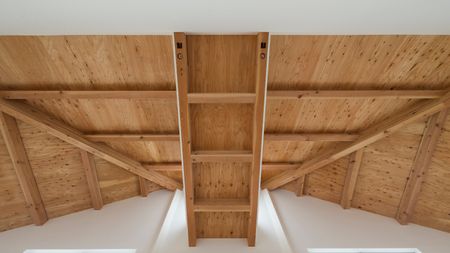 The Kumagaya House in Saitama is a modest family home subdivided by a soaring interior
The Kumagaya House in Saitama is a modest family home subdivided by a soaring interiorThis Kumagaya House is a domestic puzzle box taking the art of the Japanese house to another level as it intersects a minimal interior with exterior spaces, balconies and walkways
By Jonathan Bell Published
-
 Shigeru Ban wins 2024 Praemium Imperiale Architecture Award
Shigeru Ban wins 2024 Praemium Imperiale Architecture AwardThe 2024 Praemium Imperiale Architecture Award goes to Japanese architect Shigeru Ban
By Ellie Stathaki Published